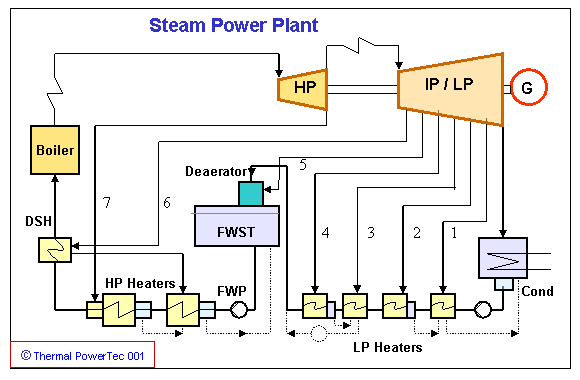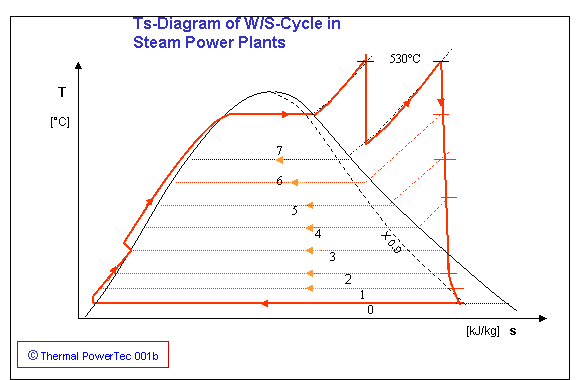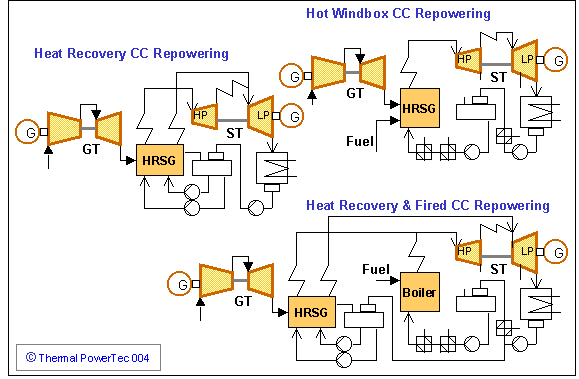Steam Power Plants
In the steam cycle of a power plant the condensate from hotwel pumped to LP pressure, heated in LP feedwater heaters 1 to 4 and deaerated in the direct contact heater/deaerator 5. The feedwater pumped to high pressure, heated in HP heaters 6 and 7 before it enters the boiler where superheated steam is produced. The steam is superheated in the boiler to 540°C. The superheated steam is sent to the steam turbine where the steam expands to low pressure providing the energy to drive a generator. The exhaust steam from the low pressure turbine has to be condensated in the condenser in order to complete the steam cycle.
The exhaust steam enters condenser-tube bundles that have cooling water circulating through the tubes. The cooling water causes the steam to condense at a temperature of about 32–38°C and that creates an absolute pressure in the condenser of about 5–7 kPa, a vacuum of about 95 kPa relative to atmospheric pressure. The condenser creates the low pressure required to increase the efficiency of the turbines. The limiting factor is the temperature of the cooling water and that is limited by the prevailing average climatic conditions at the power plant's location.
Optimization of the feedwater heaters and the water-steam cycle improved the profitability and availability of the steam power plant.
Feedwater heating
The feedwater used in the steam boiler is a means of transferring heat energy from the burning fuel to the mechanical energy of the spinning steam turbine. The total feedwater consists of recirculated condensed steam, referred to as condensate, from the steam turbines plus purified makeup water. Because the metallic materials it contacts are subject to corrosion at high temperatures and pressures, the makeup water is highly purified before use. A system of water softeners and ion exchange demineralizers produces water so pure that it coincidentally becomes an electrical insulator, with conductivity in the range of 0.3–1.0 microsiemens per centimeter. The makeup water in a 500 MWe plant amounts to perhaps 1.25 L/s to offset the small losses from steam leaks in the system.
The feedwater cycle begins with condensate water being pumped out of the condenser after travelling through the steam turbines. The condensate flow rate at full load in a 500 MWe plant is about 0.38 m³/s. The water flows through a series of six or seven intermediate feedwater heaters, heated up at each point with steam extracted from an appropriate duct on the turbines and gaining temperature at each stage. Typically, the condensate plus the makeup water then flows though a deaerator that removes dissolved air from the water, further purifying and reducing its corrosivity. The water may be dosed following this point with hydrazine, a chemical that removes the remaining oxygen in the water to below 5 parts per billion (ppb). It is also dosed with pH control agents such as ammonia or morpholine to keep the residual acidity low and thus non-corrosive.
Today the net thermal efficiency of the steam power plants lie between 0.42 and 0.47. The loss by the condensation of the exhaust steam is high and lie between 43% and 48% of the supplied heat flow.
Special Cycles for Steam Power Plants:
Feedwater waters Circuit with Steam Desuperheater to the Deaerator:
Patent EP 0972911
LP Direct Contact Feedwater Heater Cycle:
Patent DE 19524216
Circuit for LP Feedwater Heaters:
Patent EP 1041251
Repowering of Existing Steam Power Plants
Repowering an existing steam power plant can be achieved by combining it, in whole or in part, with a gas turbine into a combined cycle plant. Repowering is ideal for plants in which the steam turbines, after many years of operation, still have considerable service- live expectancy, but the boilers are ready for replacement. The boilers are normally replaced or supplemented with gas turbines and HRSG. Some plants are repowered purely in order to benefit from the efficiency increase even though they are far from the end of their design life.
Repowering increases the output and efficiency of the power plant while improving plant reliability and decreasing plant emission.
The equipment to repowering will vary from case to case and depends on technical and economic criteria: Building and foundations, steam turbine and generator, condenser and cooling system.
The size relationship between the steam turbine and gas turbine is a main efficiency driver in a repowering application. It is important to have a good fit between the size of the gas turbine and the steam turbine.
There are three main options available when deciding to repower:
1. Heat recovery combined cycle repowering
The existing fired boiler is replaced with one (or two) efficient GT and one heat recovery steam generator (HRSG) by changing a part of the water/steam cycle.
2. Hot wind box combined cycle repowering (HWBR)
Steam power plants with reheat steam turbine can be repowered using the concept of "hot wind box". One (or more) gas turbine (GT) is installed and the high temperature GT exhaust gas flows first through the windbox of the present fired boiler to utilising the existing water/steam cycle and steam turbine (ST) and then through a waste-heat recovery heater used for most of the feedwater preheating. The rest of the preheating is done using the existing preheaters and steam turbine extractions. HWBR has a high degree of technical complexity.
3. Heat recovery and fired combined cycle repowering (Hybrid PP)
A new gas turbine and new HRSG are installed in parallel to the conventional boiler to provide a second source of HP live steam for the steam turbine. During normal load the existing fired boiler can operate the steam turbine. During high load the GT and HRSG of the combined cycle process can be utilized. This concept fits especially for large steam plants and offers more flexibility than other options due to the fired boiler and HRSG for meeting the load needs.
The exhaust heat at the cold end of the HRSG is used for preheating of partial feedwater. The existing steam extractions and feed heaters are used for preheating of the part of feedwater flow, allowing steam turbine extraction flows to be reduced and increasing steam turbine output.
Three operating modes are possible:
- Original mode without the gas turbine and HRSG in operation
- Hybrid mode, where the coventional cycle, gas turbine and HRSG are in operation
- Combined cycle mode, where the GT, HRSG and ST are in opration without the conventional boiler.
The highest overall efficiencies are obtained with pure combined cycle mode and the highest output with hybrid mode.
In the steam cycle of a power plant the condensate from hotwel pumped to LP pressure, heated in LP feedwater heaters 1 to 4 and deaerated in the direct contact heater/deaerator 5. The feedwater pumped to high pressure, heated in HP heaters 6 and 7 before it enters the boiler where superheated steam is produced. The steam is superheated in the boiler to 540°C. The superheated steam is sent to the steam turbine where the steam expands to low pressure providing the energy to drive a generator. The exhaust steam from the low pressure turbine has to be condensated in the condenser in order to complete the steam cycle.
The exhaust steam enters condenser-tube bundles that have cooling water circulating through the tubes. The cooling water causes the steam to condense at a temperature of about 32–38°C and that creates an absolute pressure in the condenser of about 5–7 kPa, a vacuum of about 95 kPa relative to atmospheric pressure. The condenser creates the low pressure required to increase the efficiency of the turbines. The limiting factor is the temperature of the cooling water and that is limited by the prevailing average climatic conditions at the power plant's location.
Optimization of the feedwater heaters and the water-steam cycle improved the profitability and availability of the steam power plant.
Feedwater heating
The feedwater used in the steam boiler is a means of transferring heat energy from the burning fuel to the mechanical energy of the spinning steam turbine. The total feedwater consists of recirculated condensed steam, referred to as condensate, from the steam turbines plus purified makeup water. Because the metallic materials it contacts are subject to corrosion at high temperatures and pressures, the makeup water is highly purified before use. A system of water softeners and ion exchange demineralizers produces water so pure that it coincidentally becomes an electrical insulator, with conductivity in the range of 0.3–1.0 microsiemens per centimeter. The makeup water in a 500 MWe plant amounts to perhaps 1.25 L/s to offset the small losses from steam leaks in the system.
The feedwater cycle begins with condensate water being pumped out of the condenser after travelling through the steam turbines. The condensate flow rate at full load in a 500 MWe plant is about 0.38 m³/s. The water flows through a series of six or seven intermediate feedwater heaters, heated up at each point with steam extracted from an appropriate duct on the turbines and gaining temperature at each stage. Typically, the condensate plus the makeup water then flows though a deaerator that removes dissolved air from the water, further purifying and reducing its corrosivity. The water may be dosed following this point with hydrazine, a chemical that removes the remaining oxygen in the water to below 5 parts per billion (ppb). It is also dosed with pH control agents such as ammonia or morpholine to keep the residual acidity low and thus non-corrosive.
Special Cycles for Steam Power Plants:
Feedwater waters Circuit with Steam Desuperheater to the Deaerator:
Patent EP 0972911
LP Direct Contact Feedwater Heater Cycle:
Patent DE 19524216
Circuit for LP Feedwater Heaters:
Patent EP 1041251
Repowering of Existing Steam Power Plants
Repowering an existing steam power plant can be achieved by combining it, in whole or in part, with a gas turbine into a combined cycle plant. Repowering is ideal for plants in which the steam turbines, after many years of operation, still have considerable service- live expectancy, but the boilers are ready for replacement. The boilers are normally replaced or supplemented with gas turbines and HRSG. Some plants are repowered purely in order to benefit from the efficiency increase even though they are far from the end of their design life.
Repowering increases the output and efficiency of the power plant while improving plant reliability and decreasing plant emission.
The equipment to repowering will vary from case to case and depends on technical and economic criteria: Building and foundations, steam turbine and generator, condenser and cooling system.
The size relationship between the steam turbine and gas turbine is a main efficiency driver in a repowering application. It is important to have a good fit between the size of the gas turbine and the steam turbine.
1. Heat recovery combined cycle repowering
The existing fired boiler is replaced with one (or two) efficient GT and one heat recovery steam generator (HRSG) by changing a part of the water/steam cycle.
2. Hot wind box combined cycle repowering (HWBR)
Steam power plants with reheat steam turbine can be repowered using the concept of "hot wind box". One (or more) gas turbine (GT) is installed and the high temperature GT exhaust gas flows first through the windbox of the present fired boiler to utilising the existing water/steam cycle and steam turbine (ST) and then through a waste-heat recovery heater used for most of the feedwater preheating. The rest of the preheating is done using the existing preheaters and steam turbine extractions. HWBR has a high degree of technical complexity.
3. Heat recovery and fired combined cycle repowering (Hybrid PP)
A new gas turbine and new HRSG are installed in parallel to the conventional boiler to provide a second source of HP live steam for the steam turbine. During normal load the existing fired boiler can operate the steam turbine. During high load the GT and HRSG of the combined cycle process can be utilized. This concept fits especially for large steam plants and offers more flexibility than other options due to the fired boiler and HRSG for meeting the load needs.
The exhaust heat at the cold end of the HRSG is used for preheating of partial feedwater. The existing steam extractions and feed heaters are used for preheating of the part of feedwater flow, allowing steam turbine extraction flows to be reduced and increasing steam turbine output.
Three operating modes are possible:
- Original mode without the gas turbine and HRSG in operation
- Hybrid mode, where the coventional cycle, gas turbine and HRSG are in operation
- Combined cycle mode, where the GT, HRSG and ST are in opration without the conventional boiler.
The highest overall efficiencies are obtained with pure combined cycle mode and the highest output with hybrid mode.





izin buat di jadiin referensi yah bang
BalasHapus